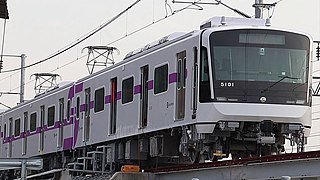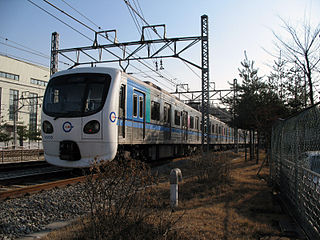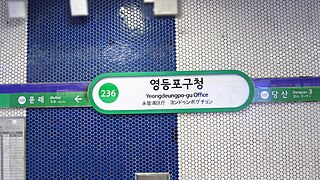
Seoul Subway Line 5 of the Seoul Metropolitan Subway, dubbed the purple line, is a long line crossing from west to the east across the Seoul National Capital Area, South Korea. It is one of two subway lines in Seoul to cross under the Han River, which is done at two points. The main line runs through to Hanam Geomdansan Station while the branch line from Gangdong Station terminates at Macheon Station. In 2019, Line 5 carried an annual ridership of 334 million or about 915,000 passengers per day.

Seoul Subway Line 2, also known as the Circle Line, is a circular line of the Seoul Metropolitan Subway. The line running clockwise is called the "inner circle line" and the counter-clockwise line is called the "outer circle line". This is Seoul's most heavily used line, and consists of the main loop, the Seongsu Branch and the Sinjeong Branch for a total line length of 60.2 km (37.4 mi). The Line 2 loop is the third longest subway loop in the world after Moscow Metro Bolshaya Koltsevaya line and Beijing Subway Line 10. In 2019, Line 2 had an annual ridership of 812 million passengers or 2.2 million passengers per day.

Seoul Subway Line 4 of the Seoul Metropolitan Subway is a long line crossing from the southwest to the northeast across the Seoul National Capital Area. The central section in Seoul City is operated by Seoul Metro with some trains offering through service to Korail's Ansan and Gwacheon Lines. The southern terminus (Oido) is in Jeongwang 4-dong, Siheung City, and the northern terminus (Jinjeop) is in Jinjeop-eup, Namyangju-si, Gyeonggi-do; the newly built northern section is correspondingly owned by a company owned by Namyangju-si, with operations contracted to Seoul Metro. In 2022, the Seoul Metro operated section had an annual ridership of 219,587,000 or about 601,608 passengers per day.

Seoul Subway Line 6 is a line of the Seoul Metropolitan Subway. The route connects Eunpyeong-gu and Jungnang-gu in a U-shaped manner, running through Yongsan-gu and Seongbuk-gu. It does not cross the Han River. It is mainly used to connect to the northern outskirts of Seoul and to relieve the traffic on other lines.

Seoul Subway Line 7 of the Seoul Metropolitan Subway was built from 1990 to 1996 and was completed on August 1, 2000 ; the western section between Sinpung and Onsu was put into service on February 29, 2000. This north-south line does not run through the city centre but links Gangnam directly to the northeastern districts of Seoul. In 2019, Line 7 had an annual ridership of 380 million or 1.04 million passengers per day. Although most trains run between Jangam and Seongnam, some trains short turn at Onsu station and some trains start at Dobongsan station.

The Incheon Subway is a subway system serving the South Korean city of Incheon. The system is operated by Incheon Transit Corporation, and is part of the greater Seoul Metropolitan Subway.

Seoul Metropolitan Rapid Transit Corporation (SMRT) was established in 1994 to operate the Seoul Subway lines 5, 6, 7, 8 in Seoul, South Korea.

Incheon Subway Line 1 is a 30.3-kilometer (18.8 mi) north-south subway line, part of the Incheon Subway system. The line is also included as a part of the overall Seoul Metropolitan Subway network; Bupyeong Station has a free transfer with Seoul Subway Line 1, Gyeyang Station connects with the AREX Line which leads to Incheon International Airport and Seoul Station, Bupyeong-gu Office Station has a free transfer with Seoul Subway Line 7, and Woninjae Station has a free transfer with the Suin-Bundang Line.

Seoul Subway Line 9, operated by Seoul Line9 Operation, is a subway line in Seoul, part of the Seoul Metropolitan Subway. The line runs east from Gaehwa station or Gimpo International Airport station along the south bank of the Han River towards VHS Medical Center in Gangdong. In 2019, Line 9 had an annual ridership of 225 million or about 616,000 people per day.

Dangsan Station (Korean: 당산역) is an elevated station on the Seoul Subway Line 2 and is an underground station on the Seoul Subway Line 9. The station is located on the south bank of the Han River in Yeongdeungpo District. Because the station is elevated, trains exiting to or entering from the north make use of the Dangsan Railway Bridge. As of April 2009, the platform has been outfitted with platform screen doors. Dangsan station is currently a transfer point between Line 2 and Seoul Subway Line 9. Several Korean TV series were shot in nearby locations, like Boys Over Flowers, Iris or My Girlfriend is a Gumiho.

Dongjak District is one of the 25 gu (districts) that make up the city of Seoul, South Korea. Its name was derived from the Dongjaegi Naruteo Ferry, on the Han River which borders the district to the north. It was the 17th gu created in Seoul, after being separated from Gwanak District on 1 April 1980.

Gangseo District(Korean: 강서구; RR: Gangseo-gu; Korean pronunciation:[ka̠ŋ.sʰʌ̹.ɡu]) is one of the 25 wards (gu) of Seoul, South Korea. It is located on the south side of the Han River. Gimpo Airport is in Gonghang-dong, where many flights fly to cities like Busan, Jeju, and Gwangju.

Yeongdeungpo-gu Office station is a station on Seoul Subway Line 2 and Seoul Subway Line 5. Before Mok-dong station on Line 5 was completed, this station served as a link to that neighbourhood via bus.

Dobongsan Station is a subway station on the Seoul Subway Line 1 and Line 7. It is the closest station to Mt. Dobong, where its name also comes from.

Incheon Subway Line 2 is a driverless, medium-capacity subway line running 29.2 km (18.1 mi) from Oryu-dong in Seo-gu to Incheon Grand Park, with 27 stations, part of the Incheon Subway system. The line is also included as a part of the overall Seoul Metropolitan Subway network; Juan station has a free transfer with Seoul Subway Line 1, Geomam station connects with the AREX Line to Incheon International Airport and Seoul Station, and Seongnam also has a free transfer with Seoul Subway Line 7.
The Seoul City in South Korea plans to build up to ten new light metro, or light rapid transit (LRT). They would be connected to the Seoul Metropolitan Subway giving access to several hundred subway stations. As opposed to traditional subway lines, LRT lines have a lower capacity.

Ilsan Line is a subway line operated by Korail, in Seoul, South Korea. Trains from this line continue to and from Seoul Metro's Line 3.

Ogeum station is a railway station on Line 3 and Line 5 of the Seoul Subway. Seoul Metro operates both Line 3 and 5 platforms. It is the southern terminus of Line 3 and travel time between Ogeum Station and Daehwa Station, the northern terminus of the line, is approximately 95 minutes.

Seoul Transportation Corporation, branded as Seoul Metro (Korean: 서울교통공사), is a municipal-owned corporation owned by Seoul Metropolitan Government, and one of the two major operators of Seoul Metropolitan Subway with Korail.

Station numbering is a sign system which assigns station codes consisting of a few letters and numbers to train stations. It aims to facilitate navigation for foreign travelers not familiar with the local language by using globally understood characters. The system is now in use by various railway companies around the world such as in Mainland China, Indonesia, Japan, South Korea, Singapore, Taiwan, Thailand, and the United States.



















